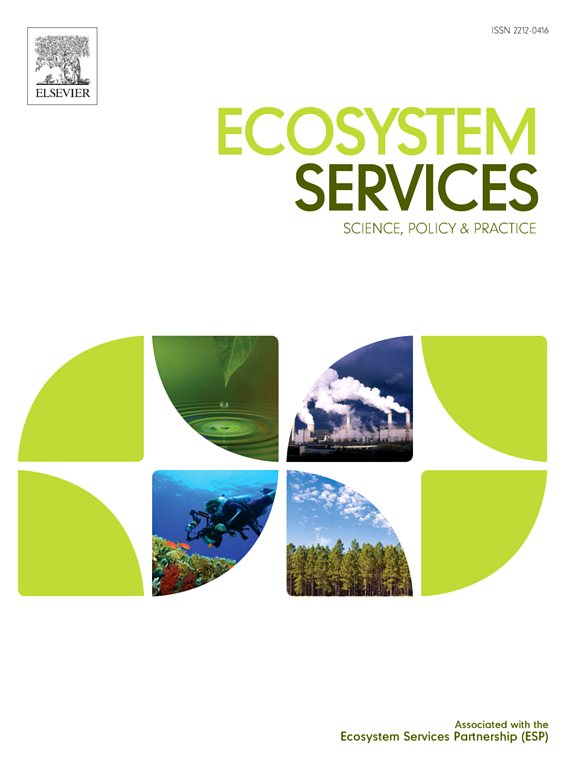Incorporating ecosystem service assessments into development planning − impact from a dredging project in South Australia on seagrass
IF 6.6
2区 环境科学与生态学
Q1 ECOLOGY
引用次数: 0
Abstract
Major infrastructure development is required for economic development and to improve human well-being, however conflict exists between developers and the community. Environmental impact assessment (EIA) is used in over 100 countries to evaluate potential impacts of major developments across environment, economy, and social benchmarks. However, EIA has been criticized for a lack of transparency and accountability, lack of consultation or participation and inadequate science. An ecosystem service assessment (ESA) recognizes the links between the environment and the socio-economic environment, resulting in a more holistic evaluation of potential impacts and effective community consultation. Despite this, its inclusion within EIA’s is rare.
An ESA was trialled within the evaluation stage of an EIA for a large capital dredging project in Adelaide, South Australia, an area dominated by long-lived seagrass. The process highlighted significant value to society from seagrass meadows, delivering provisioning, regulating and cultural services and many of these were at risk from the dredging proposal causing conflict with the community. The ESA provided clarity in links between ecological and social economic systems, assisting genuine and transparent engagement with the stakeholders and community. Monetary valuation of services provided context to decision makers arguing for changes to proposed methodology to protect seagrass and ecosystem services. Changes to the proposal resulted in substantially less seagrass loss than originally proposed, helping protect ecosystem services. This case study demonstrated the benefit of including an ESA into major development planning, increasing transparency, reducing conflict with the community, and assisting in providing a social licence to operate.

将生态系统服务评估纳入发展规划-南澳大利亚疏浚项目对海草的影响
经济发展和改善人类福祉需要大型基础设施建设,但开发商和社区之间存在冲突。100多个国家使用环境影响评估(EIA)来评估主要开发项目在环境、经济和社会方面的潜在影响。然而,环境影响评估一直被批评缺乏透明度和问责制,缺乏咨询和参与,缺乏科学依据。生态系统服务评估认识到环境与社会经济环境之间的联系,从而对潜在影响进行更全面的评价,并进行有效的社区协商。尽管如此,将其纳入EIA的情况很少见。在南澳大利亚阿德莱德的一个大型资本疏浚项目的环境影响评估阶段试用了ESA,该地区主要是长寿命的海草。这一过程强调了海草草甸对社会的重要价值,提供供应、管理和文化服务,其中许多服务因疏浚提案而面临风险,导致与社区发生冲突。ESA明确了生态和社会经济系统之间的联系,有助于与利益相关者和社区进行真正和透明的接触。服务的货币评估为决策者提供了背景,他们主张改变保护海草和生态系统服务的拟议方法。对提案的修改大大减少了海草的损失,有助于保护生态系统服务。本案例研究展示了将ESA纳入主要发展规划、增加透明度、减少与社区的冲突以及协助提供运营社会许可证的好处。
本文章由计算机程序翻译,如有差异,请以英文原文为准。
求助全文
约1分钟内获得全文
求助全文
来源期刊

Ecosystem Services
ECOLOGYENVIRONMENTAL SCIENCES&-ENVIRONMENTAL SCIENCES
CiteScore
14.90
自引率
7.90%
发文量
109
期刊介绍:
Ecosystem Services is an international, interdisciplinary journal that is associated with the Ecosystem Services Partnership (ESP). The journal is dedicated to exploring the science, policy, and practice related to ecosystem services, which are the various ways in which ecosystems contribute to human well-being, both directly and indirectly.
Ecosystem Services contributes to the broader goal of ensuring that the benefits of ecosystems are recognized, valued, and sustainably managed for the well-being of current and future generations. The journal serves as a platform for scholars, practitioners, policymakers, and other stakeholders to share their findings and insights, fostering collaboration and innovation in the field of ecosystem services.
 求助内容:
求助内容: 应助结果提醒方式:
应助结果提醒方式:


